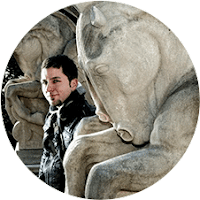 |
| G. O'Connor, Olympians: Poseidon, earth shaker Neal Porter Books: New York, 2013 |
A website created by the publisher promotes sales of the books. See www.olympiansrule.com.
Horses are sacred to Poseidon. This puzzles O'Connor, and rightly so. The ancient Greeks prayed to Poseidon as "Pelagios, Asphaleios, and Hippios" (i.e. god of the sea, god of protection from earth-quake, and god of horses), according to Pausanias (Description of Greece 7.21.7). Poseidon's affiliation with horses in myth and in cult is ubiquitous. Poseidon is regarded as the direct progenitor of the horse in cults at Thessaly and Athens, where his semen spilt upon the rock engendered the first horse. The winged horse Pegasus is the direct offspring of Poseidon's mating with Medusa, born at the gorgon's decapitation. Pegasus lighted upon the earth with a prodigious hoofbeat and opened a fresh-water spring, Hippocrene, from which the Muses draw inspiration and fresh water. Appeasement of the gods at the end of the Trojan siege was effected by means of a horse. The human-voiced horse Arion is the offspring of Poseidon, sometimes in union with an earthborn Erinys and sometimes with the earth-goddess Demeter Erinys. It is Poseidon's essential characteristic as the god of the earth, the Earth Shaker, that associates him most naturally with chthonic entities such as the
earth-born horse. (For more on this, see W. Burkert, Greek Religion (Harvard, 1985), 138 - 39.)
 |
| O'Connor, Poseidon p. 9, frm. 2 |
O'Connor's coverage of a broad set of Poseidon myths is impressive. Polyphemus and Odysseus, the
drawing of the Lots after the Titanomachy, Athena's contest for primacy in Athens, Arion's birth from Demeter, the Trojan Horse, how Theseus was both the son of Aegeas and of Poseidon, and so forth.
The audience of 9-to-14 year olds will not be too scandalized by naughtiness. No sexual nudity is explicitly drawn, though Poseidon throughout wears nothing more than a flowing loincloth. Ariadne is shown wearing one of those crazy topless
 |
| Poseidon's salt-water spring on Acropolis, Poseidon p. 49 frm. 2 |
Poseidon offers plenty of material for young geeks. I imagine my nephew poring over the genealogical tree inside the front cover. You can view it on the OLYMPIANSRULE site, also. The author's propensity to includes lots of myths in a linear narrative is appealing; plus it keeps them short. The amusing "G
 |
| O'Connor, Poseidon p. 14 frm. 1 |
O'Connor's questions about the connection between Poseidon and the horse arise several times within his Poseidon book. He is clearly amused, but also intrigued. Several references to horses, visual and stated, recur in Poseidon. A discussion question (p. 74) asks "Why do you think the God of the Sea was also the God of Earthquakes? How about horses?" Several of the "G
According to O'Connor's "Bibliography" (p. 76), "without doubt, the single most valuable resource" for classical mythology is theoi.com. I heartily wish this clever purveyor of classical mythology were inclined to pursue more authoritative source materials than what is available on the internet. The author himself notes that theoi.com is limited, in that "it's not quite complete, and it doesn't seem to be updated anymore." Still, it is delightful to see what results from O'Connor's encounters. He does The Orphic Hymns (Baltimore: Johns Hopkins UP, 2013)! ISBN 9781421408828] I'd like to see future volumes derive authority from authoritative source materials such as Oxford Guide to Classical Mythology in the Arts.
 |
| George O'Connor from olympiansrule.com |
O'Connor's recommendations for further reading range very very broadly, from good recommendations "for younger readers" like D'Aulaires' Books of Greek Myths to (under Odysseus' blurb on the facing page) a recommendation for Joyce's Ulysses as "widely consider to be one of the greatest books in the English language." OK. That's a broad range!
If I were recommending Greek mythological books for young readers — and in fact I was asked just this weekend by a family member — I would be really comfortable watching George O'Connor's Olympians continue to fly off the shelves. I ordered the set for myself this morning!
— RTM
By the way... Horses and plate-techtonics came up on Saturday's Weekend Morning Edition: click here.
 | |
| George O'Connor's Olympian pantheon, from olympiansrule.com |